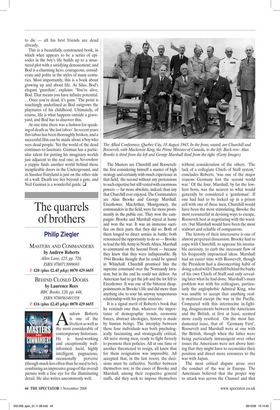Life among the dead
S. E. G. Hopkin
THE GRAVEYARD BOOK by Neil Gaiman Bloomsbury, £12.99, pp. 312, ISBN 97890747596837 ‘There was a hand in the darkness, and it held a knife.’ The Graveyard Book has one of the most arresting opening sentences one could imagine. Fortunately, Neil Gaiman then leaves melodrama for something much more interesting and thoughtful. By chance, as a toddler, Bod, the central character of the story escapes the assassin who has killed his family, and wanders into a graveyard, where he is adopted by the ghosts. Gaiman observes one of the principal rules of fantasy, which is to have rules — nothing is duller than a dream-world where anything can happen. The ghosts of his world stay as they were at the moment of their deaths, and cannot usually leave the place where they were buried. They are generally referred to by name, dates, and a monumental mason’s pious sentiment (‘Doctor Trefusis, 1870-1936, May He Wake to Glory’). The graveyard is a fascinating world for a child ; as Bod grows, he learns to read from the tombstones, hears history from the people who were there — the oldest known ghost is a Roman, but the graveyard is older than that — and acquires a few spectral skills.
Anything less like the conventional Hallowe’en horrors of spooks and chains it would be difficult to conceive. The dead — and the undead — are kindly; although Gaiman gives us a few genuinely frightening moments, they are created by older and nastier beings. On the other hand, the living can be spiteful and deceptive. It is hardly surprising that Bod says that he is not afraid to die — all his best friends are dead already.
This is a beautifully constructed book, in which what appears to be a series of episodes in the boy’s life builds up to a structured plot with a satisfying denouement; and Bod is a charming hero, courageous, considerate and polite in the styles of many centuries. Most importantly, this is a book about growing up and about life. As Silas, Bod’s elegant ‘guardian’, explains: ‘You’re alive, Bod. That means you have infinite potential. . . Once you’re dead, it’s gone.’ The point is touchingly underlined as Bod outgrows the playmates of his childhood. Ultimately, of course, life is what happens outside a graveyard, and Bod has to discover this.
At one time there was a fashion for speaking of death as ‘the last taboo’. In recent years this taboo has been thoroughly broken, and a successful film can be made about a boy who sees dead people. Yet the world of the dead continues to fascinate. Gaiman has a particular talent for putting his imaginary worlds just adjacent to the real one; in Neverwhere a yuppie finds another world behind those inexplicable doors in the Underground, and in Stardust Fairyland is just on the other side of a wall. Death too lies beyond a gate, and Neil Gaiman is a wonderful guide. q



































































































 Previous page
Previous page